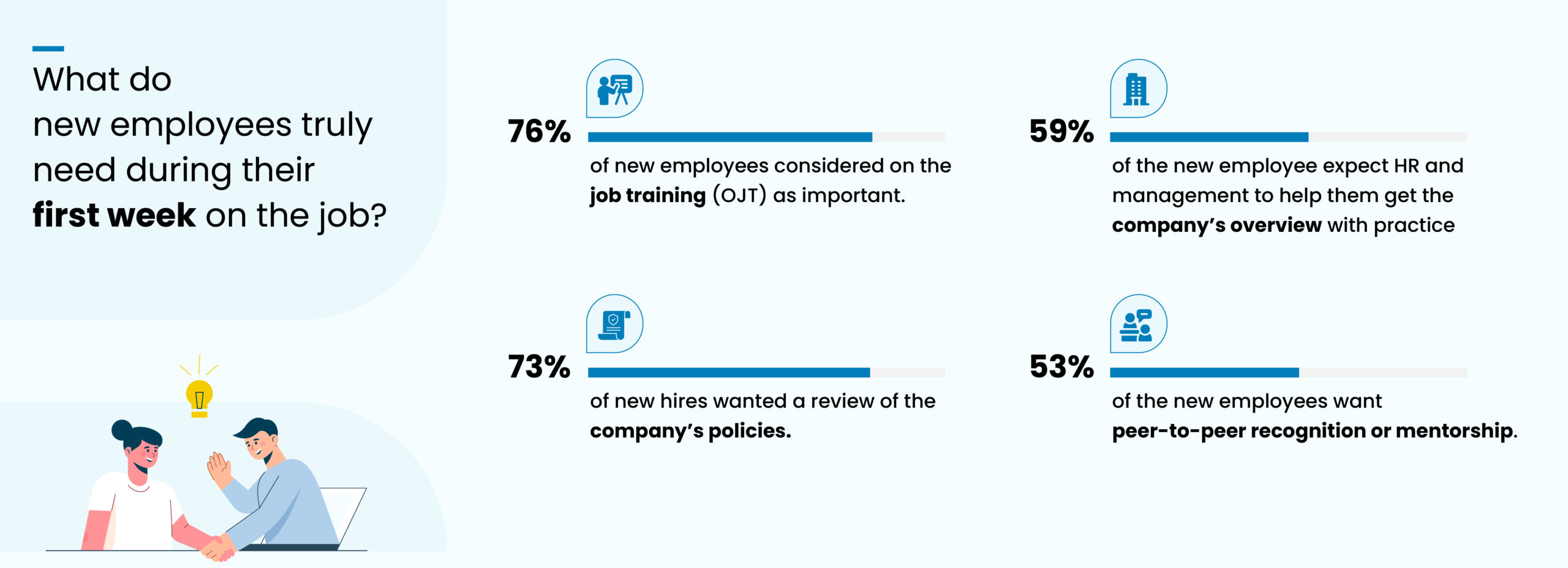A proper new hire onboarding process is essential for business success. Organizations that onboard abiding by the best practices witness more engaged employees than those that don’t have one at their disposal. While employees value the onboarding experience a lot, employers are not yet living up to their expectations. Where is the gap and what can one do to address it? Let’s try to find out.
In this post, we’ll discuss about the importance of onboarding, the four phases of onboarding, and what the new hires expect once they sign the offer letter.
What is onboarding and when does it begin?

Also known as organizational socialization, employee onboarding is the process by which a new employee is initiated into the organization. At an informal level, employee onboarding steps involve showing the employee around your office building, introducing them to their peers, and maybe telling them where they can go to grab a snack or even take a nap. At a more formal level, new hire onboarding process involves training, documentation, and familiarizing the employee with the requirements of their role as well as the related targets or goals.
So when does employee onboarding start? While there seems to be some disagreement on the exact time, there’s consensus that the onboarding process begins when the new hire hears about you and applies for a job with your organization. From this point on, your HR brand becomes evident to them. If they look at you as an organization where they can grow and evolve as a person and a professional, then you have already begun to onboard them from an acculturation perspective.
Even though onboarding begins here, the process could go on for anywhere between 30 to 365 days from the day of the new hire’s joining. The consensus says onboarding usually takes around three months at a minimum, but this timeline can vary across organizations and roles. What matters is that by the end of the onboarding process, the employee should be completely assimilated into the organization and have a thorough understanding of what their role demands of them.
What are the 4 phases of onboarding?
New hire onboarding process is primarily divided into 4 phases:
- The initial development phase is the first step towards a successful employee onboarding process. It involves helping the new hires understand the company culture and become a vital asset to the team.
- Ongoing development is the next phase in the new employee onboarding process. This might include recruiting for promotions or opportunities for employees to acquire new skills or improve their current position.
- Employee retention is an integral part of the onboarding process. The key to ensuring high employee retention is improving employee engagement and job satisfaction.
- Finally, separation is the process of helping employees exit the company successfully.
Why employee onboarding matters to organizations?

Aside from the increase in retention rate mentioned above, employee onboarding can also increase productivity by 70%. After all, this is the first interaction your new hire is having with the organization, and if that can affect their productivity in the long run it surely warrants your attention.
A proper and planned new hire onboarding process ensures your new hire does not feel lost, knows their role inside out, and knows who to approach when they need something done. If the positives of onboarding are not enough, allow us to tell you that the new hires who have a negative onboarding experience are twice as likely to look for another opportunity in the future.
What do new hires want during the onboarding process?
After months of sourcing, recruiting, interviewing, and finalizing a candidate, now you’re all set to welcome your new employee. So, what should be done to make them stick around? Here are five things you must ensure during new employee onboarding process:

One-on-one meeting with direct managers
The one-on-one meeting is the most effective way for managers to communicate with their employees and build a strong relationship by making each other comfortable within the zone. When employees and supervisors communicate frequently and share feedback (both ways), they appear to be more engaged in the workplace.
One-on-one meetings scheduled by hiring managers help new hires get enough time to adjust to the new environment, work pattern, ethics, schedules, and get comfortable with the senior level management or direct managers.
Clarity on long-term expectations
Management can help new employees by providing basic information such as best practices for specific jobs. It will support them while they learn about their new job, goals, and responsibilities, increasing their productivity. Career development plays a major role in setting long-term goals.
To rise in their profession, new employees should know what the company is expecting from them, how they can move ahead, and how far they need to go to reach their goals. It is your responsibility to set a goal for them and let them know what the company is expecting from them so that they work and perform better.
Explanation of their task for the first week
The first week of new hire onboarding process should be meticulously prepared. Any novice is indeed hesitant when they step for the first time into the office. Your old team has mastered their work, but the new employee has a lot to learn.
Consider what new hires can accomplish when planning activities for the first week. Now consider what’s necessary for them to succeed in the work they’ve set out to achieve. Guiding them in the first week will help them learn faster.
However, it appears that you won’t be able to address all work during the first week thoroughly. Remember that you only have about 35-40 hours in the first week. So, your plan must be simple. Your new hires should understand what needs to be done and be confident in their abilities to fulfill the tasks at hand.
Emphasize on corporate culture
There are several companies portraying their work culture as their USP. However, the fact is today’s generation believes more in practice than in theory. They should receive formal and relevant information about the company and its work culture. It is important to tell the new employees that the company delivers what was promised to them at the time of hiring.
Relation building exercise between new and existing employees
Most successful people would tell you that the people around them have had a huge impact on their achievements. Your new team member should trust other team members for a strong network system.
Building strong relationships with team members can go a long way towards providing your new hires with the context they need to accomplish their tasks effectively. Relationships require time, work, and attention to build properly, but they’re an essential part of long-term success.
The management, therefore, must ensure that new hires interact with every individual in the team. They should also be sent to other departments (work-related) to introduce themselves. This way, they will know other people that will help them in the long term.
Why improve the employee onboarding experience?
The new employee onboarding process is the moment that can engage or disengage a new employee with the organization. Rather than using the opportunity to connect with new hires, HR professionals typically overwhelm them with loads of materials and information during orientation. An effective new employee onboarding process helps new hires in adapting to the organization and supports the formation of working relationships. The best onboarding practices begin as soon as an offer letter is signed, which normally lasts for at least the first year of work.
How does one build a successful onboarding program?

The fact that you must plan for the onboarding of new hires and design a program that helps assimilate them smoothly is a no-brainer. To do this, however, one needs to step into the shoes of the new hire. Understanding what new hires want when they join a new organization could help. And that’s exactly what we’re here to help you make sense of.
Assign a buddy for your new hire
56% of new hires who interacted with their buddy within the first 90 days of joining showed higher signs of productivity. New hires are often stuck between trying to understand their job role and showing that they are up to speed, and this is precisely where a buddy comes in handy. Considering a buddy is usually a colleague or an immediate senior, this gives the new hire an extremely accessible mentor-cum-friend to go to for work queries or even to simply get the hang of the office building.
So, match your new hire with a buddy who has enough time on their hands to interact and show around. Also, send out timely reminders to the buddy to ensure they check in on or simply have a water cooler chat with the new hire. Letting the buddy and the new hire know that this is a time-bound and temporary partnership might also help ensure both are invested more in it.
Assure one-on-one time with the manager
72% of new hires cite one-on-one interactions with their direct manager as a top priority during the onboarding process. The manager is often one of the first people your new hire interacts with and this interaction usually begins during the interview process itself. Hence, preference for individual interactions or guidance from one’s manager is probably one of the most predictable needs a new hire has. Be it an understanding of their job role, knowing what the organization expects from them, or sharing any new ideas they might have, the manager is understandably the one person who would need to handhold the new hire into the organization, even if it is just initially.
When building an onboarding program, ensure the direct/reporting manager sets out specific time slots to have one-on-one interactions with the new hire. The manager-employee relationship is one of the most crucial relationships that the new hire would build within the organization. It is also critical to the new hire’s professional development and growth. An onboarding program that assists the new hire in building this relationship will lead to a satisfactory onboarding experience.
Give a clear outline of performance goals
67% of new hires want to know what the organization expects of them. New hires do not just want to know what to do but would also like a walk-through of how to fulfill what is expected of them. Knowing what is expected of them and being directed to the right resources and career growth opportunities can help employees advance their skills. It makes perfect sense for them to want this information as soon as they join the organization. Interestingly enough, as per the same study cited above, women rank the need for this information a lot higher than men do.
A new hire onboarding process that informs your new hire about the opportunities they can use to climb the ladder is mutually beneficial. Employees who grow and are invested in the organization lead to a positive work environment and might even motivate their colleagues, increasing your organization’s employee engagement rate. So, inform your new hires about where the rungs are and allow them to climb as high as they deserve to.
Conclusion
That brings us to the end of the employee onboarding steps you should keep in mind to get onboarding right. Whether or not you use these pointers, do remember to prioritize onboarding and not leave your new hires in the maze. So long as you do that, you’re on the right track.
Speak with our experts!
Schedule a demo todayFrequently Asked Questions
What are the 5 C’s of onboarding?
The 5C’s of onboarding are:
Compliance: Compliance refers to a person’s basic awareness of your company’s policies, safety standards, confidentiality requirements, and departmental processes.
Clarification: Clarification means communicating expectations regarding job performance. This includes but is not limited to safety, equipment, and job performance.
Culture: Culture includes all formal and informal, expressed, and unspoken beliefs and values that contribute to the environment of work.
Connection: Connection means how an employee understands and relates to the work through relationships and channels of knowledge.
Check back refers to a manager’s obligation to check in with a new hire from time to time for the first three months.
What do employees expect from onboarding?
New employees want to come to work quickly and contribute. They want management to inform them about their role, their closest colleagues, and with whom they will communicate to facilitate. They also expect a clearly defined function, a schedule they will follow for the first week or two, and transparency in communication.
What new hires should know?
The new hires should know about the 5Cs of the company. The onboarding process should include the company’s goal, mission, and values and details about benefits enrollment, corporate holidays and policies, company structure, and team culture.
What are the objectives of onboarding?
The goal of an onboarding program is to assist new employees in becoming familiar with the company’s purpose, vision, strategic goals, and priorities. This also involves providing recruits with the necessary skills, information, and culture over time so that they may make a positive contribution to the business in which they work. The ultimate goal of a healthy onboarding is to attract and retain talent and increase employee engagement, thereby resulting in business growth.
What makes a good onboarding process?
There is no one approach to effective onboarding. Onboarding programs may differ depending on the size and culture of the company. However, there are three common components used for a successful onboarding process:
- Operational: Ensure that new employees have the necessary materials and information to do their jobs properly.
- Social: Make new hires feel welcomed, form, and promote meaningful relationships with coworkers and management, and make them feel a part of the company.
- Strategic: Ensure that newcomers are familiar with the organization’s vision, structure, mission, important developments, goals, and culture.







2 Comments